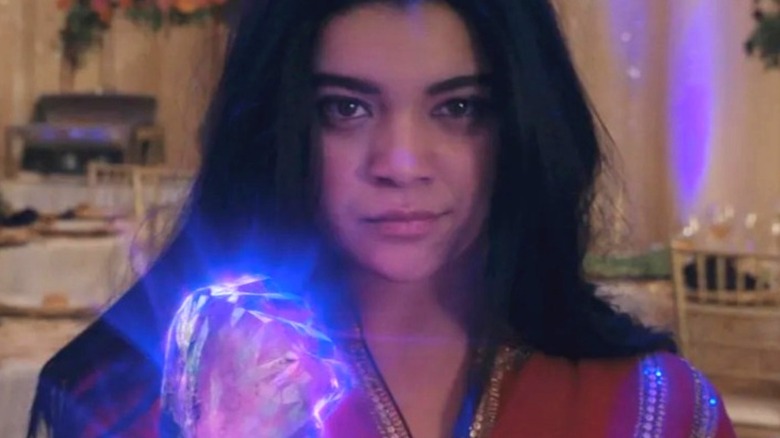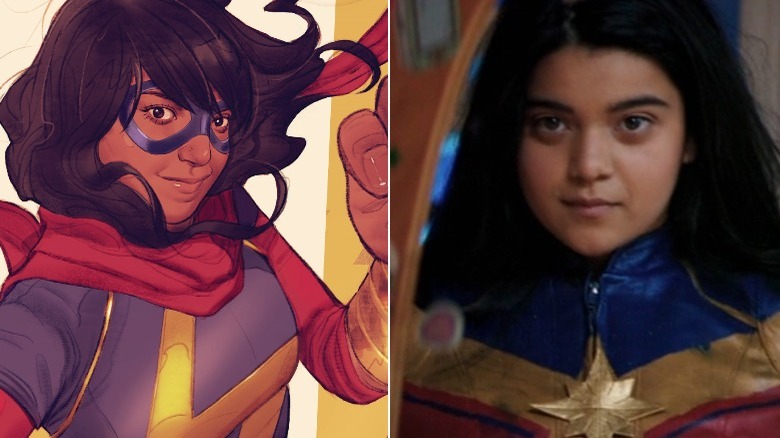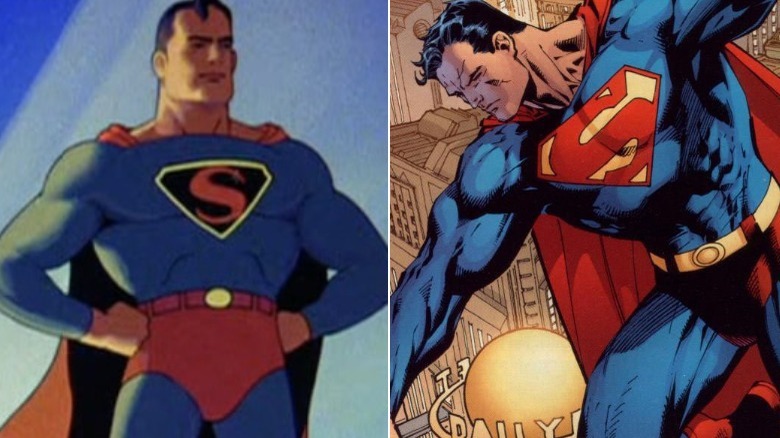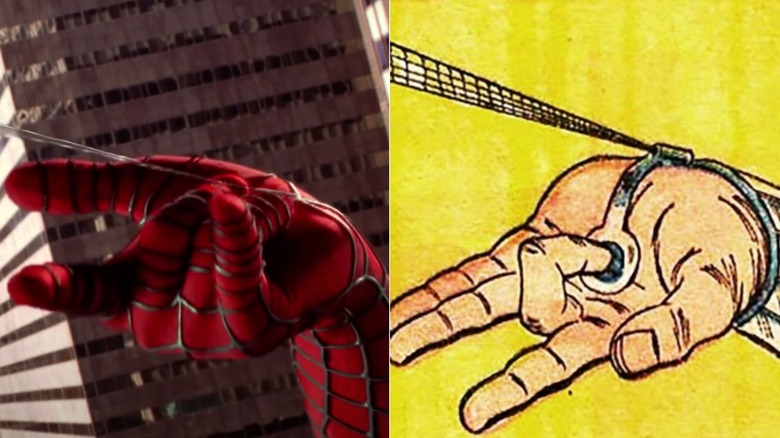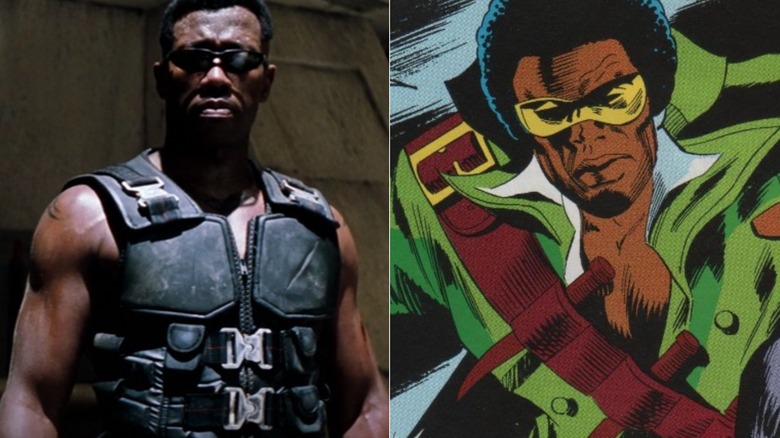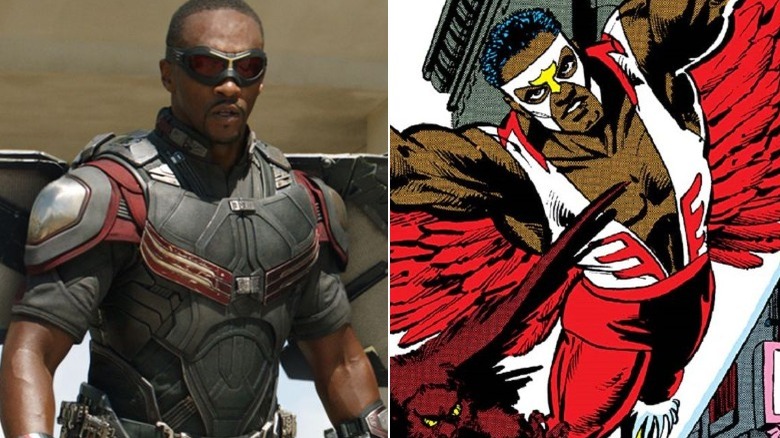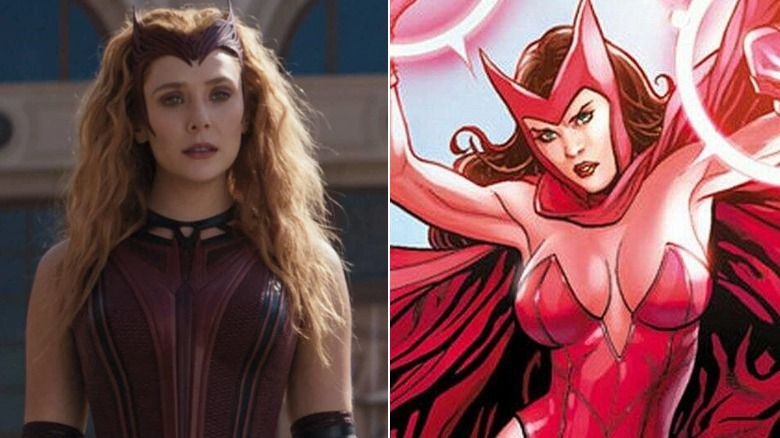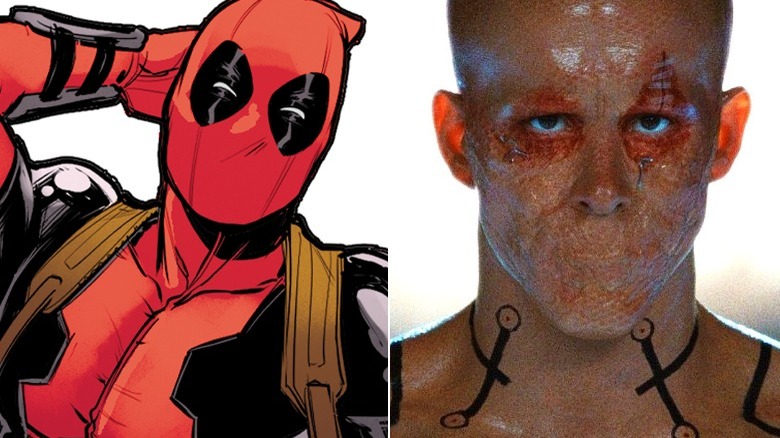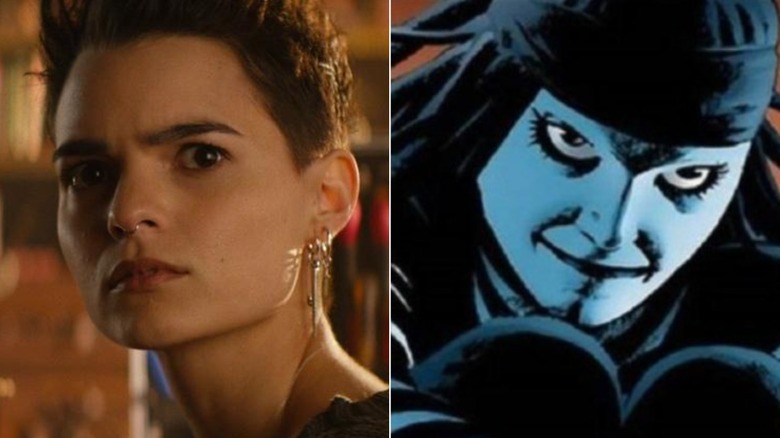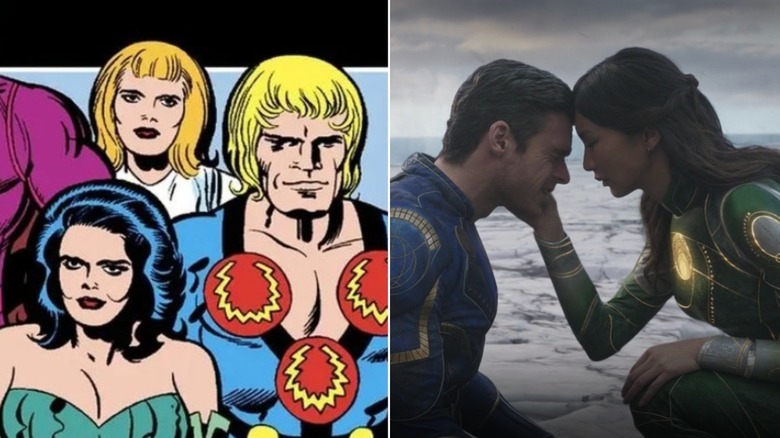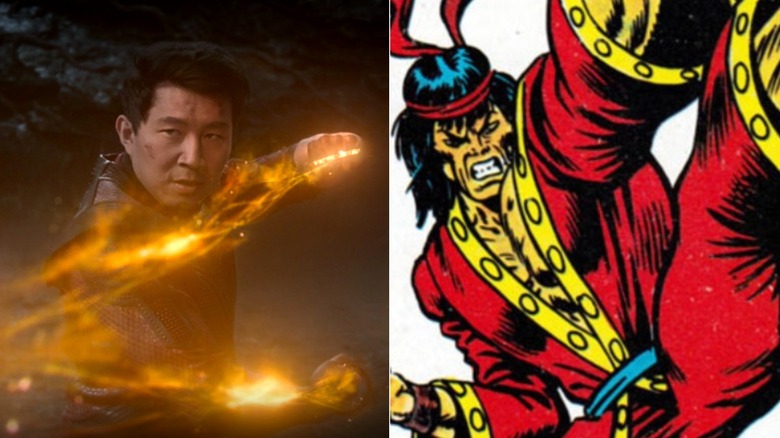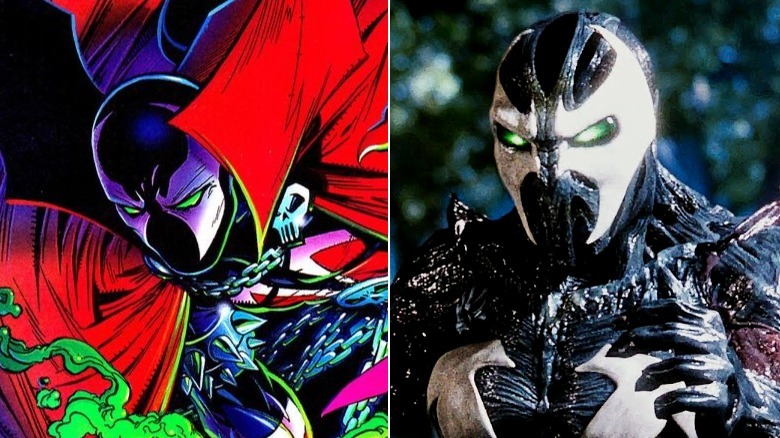Superhero Powers That Were Changed On-Screen
When a story or character is adapted from one medium to another, adaptation changes are mostly unavoidable. What works in one medium won't necessarily translate well into another. Sometimes it's easy to understand why these changes were made ("Lord of the Rings" aging down Frodo Baggins) while other times, less so ("Super Mario Bros." turning into a dystopian cyberpunk thriller). This is especially true for comic book adaptations.
When superheroes are adapted to live-action film or TV, they often tone down their colorful costumes or ground their more outlandish concepts. Much more rare, however, are adaptation changes that fundamentally alter the superhero's defining superpowers. With the new trailer for the upcoming Disney+ show "Ms. Marvel" appearing to confirm that Marvel Studios has entirely altered the character's abilities, this conversation has been sparked once again. But in addition to Kamala Khan, what are some other superheroes who have had their powers drastically changed after being adapted into a different medium?
Due to the sheer volume of content produced by Marvel Studios since 2008, we'll be talking a lot of Marvel Cinematic Universe (MCU) here, but Marvel properties adapted by other studios are also fair game, as are properties based on DC Comics and even the lesser-known Image Comics!
Ms. Marvel
If the trailer is any indication, most of what makes Kamala Khan (Iman Vellani) such a fan-favorite comic book character — her fan-girling over superheroes and being an awkward but endearing daydreamer — remains intact in the new adaptation. Her power set, however, seems to have been completely revamped for the show. In the comics, Khan can polymorph, which usually manifests in her stretching or growing out her limbs to superhuman size. However, in the most recent trailer, she's creating glowing energy constructs like a Green Lantern (though we do see her use these powers to create a giant fist, so that's something).
There are many reasons — and a lot of speculation — as to why Marvel and Disney might have made this change for the show. These include a (relatively) limited TV budget to do stretchy skin effects, wanting to have her powers more closely resemble those of Brie Larson's Captain Marvel (who she'll co-star alongside in 2023) or her original powers being too close to those of Mr. Fantastic from the Fantastic Four, who made his MCU debut in "Doctor Strange in the Multiverse of Madness." Whatever the case may be, the rest of the show seems to be comics-accurate — at least for now.
Superman
What's the first thing fans usually think when they think of Superman? Some might say his weird spit-curl, but they would be wrong, because the correct answer is, of course, flight. It's such a core tenet of his character that the tagline for the original 1978 film starring Christopher Reeve was "You will believe a man can fly".
However, as hard as it is to believe, Superman didn't start out with the ability to fly. In fact, that's the reason he originally was only able "to leap tall buildings in a single bound" — because all he could do was jump really high. His ability to fly didn't come about until Max Fleischer (who produced the famous Betty Boop and Popeye cartoons) adapted the character into animated serials in the 1940s.
It turns out that animating Superman constantly jumping in the air was beyond the technology of the era, and expensive to produce — having the hero just fly through the sky was found to be relatively easier (and cheaper) to animate. Superman's comic book counterpart soon followed suit, and the rest is history.
Spider-Man
Spider-Man has been swinging around New York since 1962's "Amazing Fantasy #15", and to do it, he's almost always had to use mechanical web-shooters and specially-designed web fluid. While many fans prefer this origin, it always stretched credulity to a certain degree, even for comics, that a kid struggling to pay rent somehow had the resources to make devices that rival state-of-the-art military tech. It would also have made perfect sense for Peter Parker to have gained innate web powers from his radioactive spider bite along with his other abilities (climbing on walls, relative super-strength, speed, and agility), none of which are spider-specific like web-spinning is.
When James Cameron was tasked with writing and directing a "Spider-Man" feature film in the early 1990s, one of his biggest adaptation changes was turning the hero's web-shooters from mechanical to organic. When that version of the film fell apart and director Sam Raimi took over, Raimi decided to keep the organic web-shooter idea Cameron introduced. Afterward, Marvel Comics used a mutation storyline to make Parker's web-shooters organic, as well, though this didn't last long — the controversial 2007 crossover "One More Day" erased the mutations and restored the original web-shooters, and subsequent Spider-Man reboot films have also maintained their mechanical nature.
Blade
It can be reasonably argued that 1997's "Blade," starring Wesley Snipes in the title role, is the comic book film that helped kick off the current domination of superhero movies today. While movies adapted from comics had certainly been successful in the past, "Blade" was one of the first that wasn't based on a household name like Batman or Superman — in fact, he was relatively obscure. It was also the first big hit to feature a Marvel Comics character, leading to studios eventually taking a chance on "X-Men" and "Spider-Man," which themselves led to the MCU (where the new version of Blade has already made his vocal debut).
However, one of Blade's defining characteristics in the films — that he is essentially half-vampire, with all of the vampires' strengths and none of their weaknesses, known among vampires as a "daywalker" because he can survive in the sun — was entirely made up for the movie. In the original comics, he was just a regular human whose one special gift was that he couldn't turn into a vampire when bitten (and even that didn't come up very often). After the success of the films, however, Marvel changed Blade's powers to more closely align with the version played by Snipes, which is now the iconic image of the character.
Falcon
While the superhero Falcon (aka Sam Wilson, played in the MCU by Anthony Mackie) hasn't had a solo film yet, he is still a fan-favorite due to Mackie's scene-stealing performance in "Captain America: The Winter Soldier" and subsequent MCU films. This eventually led to a lead role in the entertaining — if flawed — Disney+ show "The Falcon and the Winter Soldier."
In the MCU films and show, Falcon is just a regular human soldier who is specially trained to pilot what can best be described as jet-powered wings (thus his name). He can certainly go toe-to-toe with some super-beings due to his military training, but he has no actual superpowers to speak of. In the comics, however, he did have one power: the ability to talk to birds. These included a bird companion named Redwing that would help him fight crime (in the films, of course, Redwing is the name of Falcon's mechanical drone).
The decision to take away Sam Wilson's avian communication abilities and replace them with something more grounded to better fit the tone of the "Captain America" franchise is perhaps the most understandable of any of the changes referenced here. And at any rate, the MCU did, at least, follow the comics by having Sam eventually become Captain America in his own right.
Scarlet Witch
Marvel Entertainment head honcho Kevin Feige has stated that Wanda Maximoff (Elizabeth Olsen) is the most powerful character in the entire MCU. You can see what he means on several occasions in the films she's appeared in so far, such as her psychically manipulating the Hulk in "Avengers: Age of Ultron" and taking on Thanos single-handedly during the climax of "Avengers: Endgame."
However, as powerful as she is in the MCU, the Scarlet Witch is exponentially more powerful in the comics, where she's a mutant with the ability to literally alter reality, to the point where she wiped out 90% of the mutant population in the 2005 event series "House of M". In the films, her powers so far have been mostly limited to an extremely broad definition of telekinesis, some vague telepathic abilities, and shooting off bolts of unknown red energy.
In the 2020 Disney+ show "WandaVision", the Scarlet Witch finally got her name and some semblance of her comic book powers, creating her own artificial reality and resurrecting her android lover, Vision. She became even more powerful (and, to an extent, more comics-accurate) in "Doctor Strange in the Multiverse of Madness."
Deadpool
It's pretty obvious at this point that Ryan Reynolds was born to play Deadpool, Marvel's resident "Merc with a Mouth." But while 2016's "Deadpool" and its 2018 sequel "Deadpool 2" hewed pretty closely to the comics (especially concerning the character of Deadpool himself), those weren't the first times Reynolds played the character.
In 2009's "X-Men Origins: Wolverine," Reynolds played Wade Wilson in one of the film's early action set-pieces in a characterization that was broadly accurate. However, this was before Wilson turned into Deadpool in the last act ... and that's when things really went off the rails. The film's version of Deadpool looked nothing like his comic book counterpart, his power set included both teleportation (without a device) and Cyclops' concussion beam, and — worst of all — they sewed his mouth shut. This is probably one of the most egregious character adaptations in the history of superhero films, and it's no surprise that, unlike some other examples, this version of Deadpool is now nothing more than inside joke material.
Negasonic Teenage Warhead
Although Deadpool's character was pretty accurate in the "Deadpool" films, one character who had a major change to her powers when blasting off from page to screen was his teen sidekick, Negasonic Teenage Warhead (named by creator Grant Morrison after a Monster Magnet song of all things), played by Brianna Hildebrand.
In the comics, Negasonic Teenage Warhead was originally a mutant with precognitive and telepathic powers. In the "Deadpool" films, however, her powers changed to something more befitting her explosive name — namely, the ability to generate explosive charges from her body. These new powers are similar to the comic book character of Cannonball, who the filmmakers considered including. However, they ultimately thought it would be more fun to have the character be a sardonic goth girl to contrast Deadpool's manic energy (they also loved her name). The end result of all this was that Negasonic Teenage Warhead, originally an extremely minor comics character killed off in her very first issue, was brought back for the Marvel Comics series "Deadpool & the Mercs for Money" and given an appearance and power set that mimics the character from the "Deadpool" movie franchise.
The Eternals
The original "The Eternals" comic series, written and drawn by legendary artist Jack Kirby, is about a group of powerful and immortal god-like beings who are the basis of human myths and legends. They were sent down to ancient Earth by even more powerful Celestial beings to protect humans throughout history from the monstrous Deviants. All the heroes in the group shared similar powers — for instance, each of the Eternals possessed super strength, invulnerability, flight, telepathy, and a myriad of other latent psionic and magical abilities. Of course, certain characters were better at certain powers than others (Sersi was better at using magic than Ikaris, for example), but otherwise, they all had a relatively equivalent power set.
However, in the star-studded 2021 feature film "Eternals," director Chloé Zhao made the decision to split these superpowers among the Eternals, giving each their own unique ability. Only Ikaris can fly, only Sersi can transmute objects, only Makkari has super speed, etc. This helped differentiate the Eternals and made the film generally less cluttered and confusing than it may have been otherwise.
Shang-Chi
While ostensibly a superhero film, "Shang-Chi and the Legend of the Ten Rings" succeeded by being, first and foremost, a fun fantasy martial arts film. The stunts were visceral and brutal, while the plot was mostly a personal story about family and tradition.
However, many changes were made to the original character's power set from the comics. In the source material, Shang-Chi was just a regular (though highly-skilled) martial artist. The closest to "super powers" Shang-Chi possessed was his ability to harness his "chi", but it is implied that anyone could potentially do that as well, as long as they trained hard enough (he also briefly had the ability to duplicate himself, but that lasted about as long as Captain America was a werewolf).
In the film, Simu Liu's Shang-Chi comes to possess the eponymous "Ten Rings," which are also completely different from their comic book counterparts (and mostly unrelated to Shang-Chi). In the comics, the Ten Rings are literal rings that are worn on each finger, each of which confers its own unique power (i.e. fire and lightning). The Ten Rings in the film are more like conduits for energy that can be used as whips, projectiles, and propulsion. It's unclear exactly how much of this change was the result of a desire to retcon certain aspects of "Iron Man 3," but whatever the reasons, we're not complaining.
Spawn
It cannot be overstated how ubiquitous Image Comics' "Spawn" was in the early-to-mid 1990s — he adorned t-shirts, toys, video games, posters, and of course, comics. This was even more impressive considering how mature the comics themselves were, featuring dark themes and depictions of graphic violence.
This popularity led, inevitably, to a big-budget feature film from New Line Cinema in 1997. To the film's credit, it's actually fairly accurate to the comic book, following U.S. special agent Al Simmons (Michael Jai White) after he's betrayed and killed by his evil boss, a sequence of events which was itself set in motion by the demon Malebolgia in order to turn Simmons into a Hellspawn (or simply Spawn) who will lead Hell in a war against Heaven.
The only real adaptation change — and it's a pretty big one — is the fact that in the film, Spawn doesn't have a necroplasm counter. In the comics, Spawn's powers derive from the necroplasm in his suit, which, once depleted, would send him permanently back to Hell with no chance for escape. This means that, despite his demonic abilities being extremely powerful, he has to be sparing with them while on Earth, giving him natural limitations. While the movie version does incorporate the idea of necroplasm, there's no mention of the counter, meaning the film has to rely on other sources of dramatic tension. Perhaps the necroplasm counter will finally appear on screen in the "Spawn" reboot film — assuming it ever gets made.
